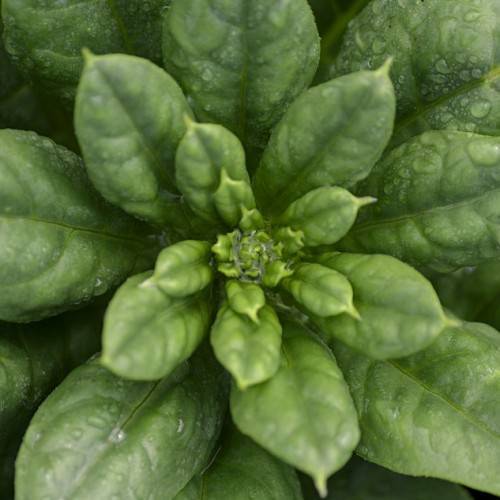
spinach
Spinacia oleracea
Cycle:
Annual
Watering:
Average
Hardiness Zone:
2 - 11
Flowers:
Flowers
Sun:
Full sun,part shade
Leaf:
Yes
Growth Rate:
Low
Maintenance:
Moderate
Drought Tolerant:
Yes
Salt Tolerant:
Yes
Care Level:
Medium
watering
Water your spinach plants deeply, but infrequently. Water them once or twice a week, providing enough water to reach 6–12 inches deep. It’s best to water them in the morning so the leaves dry off quickly and to discourage fungus. In hot, dry weather, you may need to water more often.
sunlight
Spinach (Spinacia oleracea) requires 6 to 8 hours of direct sunlight per day. For optimal growth, spinach should be provided with full sun exposure during the morning hours before the hottest part of the day. In climates with very hot summers, light shade in the afternoon may be beneficial. Spinach grows well in temperatures ranging from 45 to 75°F and will not tolerate high heat or temperature extremes.
pruning
Spinach (Spinacia oleracea) should be pruned regularly throughout the growing season. Plants should be deadheaded to promote fuller and healthier foliage. Pruning should occur in early summer and again in late summer. In early summer, prune off the top 2-thirds of the plant. This will create a bushy shape, reduce the risk of disease, and help ensure a healthy harvest. Make sure to remove any dead or diseased leaves as well. In late summer, pinch out the top of the main stem and remove any flower buds that appear. This will prevent the plant from bolting and focus it's energy into producing a healthy harvest. Try to maximize the area for future foliage growth by pruning any branches that may have gone awry during the growing season. In summary, prune Spinach (Spinacia oleracea) regularly throughout the growing season - early summer and late summer - to promote fuller, healthier foliage and a healthy harvest. Remove any dead or diseased leaves, pinch out the top of the main stem and remove any flower buds, and prune any branches that have gone astray during the growing season.
Season
Hardiness Map
FAQ
Do spinach leaves contain antioxidants?
Yes, spinach leaves do contain antioxidants. Spinach is a type of leafy green vegetable and is known for its powerful nutritional qualities. Spinach contains many minerals and vitamins, and is considered to be one of the most nutrient-dense vegetables in the world. Spinach is a good source of flavonoids and polyphenols, both of which are powerful antioxidants that can help protect our cells from damage and can offer anti-inflammatory properties.
Is spinach a good source of vitamins?
Yes, spinach is a great source of vitamins. It is an excellent source of vitamins A, C, and K. It is also a good source of folate, iron, magnesium, and other important nutrients. Vitamin A is essential for eye health and cellular growth, while vitamin C supports immune system health and helps with the absorption of iron. Vitamin K is essential for bone health and blood clotting. Finally, spinach also contains phytonutrients, which are beneficial compounds found in plants and have antioxidant properties. Eating spinach can help ensure that you are getting these vital vitamins and nutrients from a single food source.
Are there different types of spinach?
Yes, there are different types of spinach. The most common type of spinach is known as flat-leaf spinach or smooth spinach, with a mild flavor. Another type of spinach is called Savoy, which has ruffled leaves, and is generally more flavorful than flat-leaf. Baby spinach is a smaller version of flat-leaf which has a more delicate texture and flavor. Perpetual spinach is another type which regrows quickly after it is harvested and has a milder taste than other varieties. Finally, there is New Zealand spinach which is grown for its seeds rather than its leaves.
Is spinach a low-calorie vegetable?
Yes, spinach is a low-calorie vegetable. One cup of cooked spinach contains only 41 calories per serving. Spinach also has a high nutritional value; it is an excellent source of dietary fiber, vitamins A, C, E, and K, potassium, magnesium, iron, and calcium. Spinach is also packed with antioxidants that help protect the body from free radical damage. By adding spinach to your diet, you'll not only benefit from its low-calorie content but its numerous health benefits as well.
Do spinach plants need regular thinning?
Yes, spinach plants need regular thinning. When spinach is grown in a garden, it needs to be thinned to allow for plenty of space between plants. This will give the plants more room to grow and will help prevent them from overcrowding and becoming too dense. Thinning should be done once the plants have reached about 4 inches tall, and should be done every two weeks or so until the desired spacing is achieved. Additionally, when harvesting spinach from the garden, it is wise to pull out more than you need, leaving the strongest plants to grow. This will help to keep the crop healthy and ensure plentiful harvests throughout the season.
Could you grow spinach in a greenhouse?
Yes, it is possible to grow spinach in a greenhouse. Spinach plants prefer cooler temperatures and high amounts of humidity, which makes a greenhouse an ideal environment for growing the vegetable. When properly managed, a greenhouse provides temperature consistency and creates a humid atmosphere which are both necessary for spinach growth. In addition, having a covered soil bed in the greenhouse means that spinach will not be exposed to the environmental elements like wind, hail, frost, and rain, which can all have a negative effect on growth.
